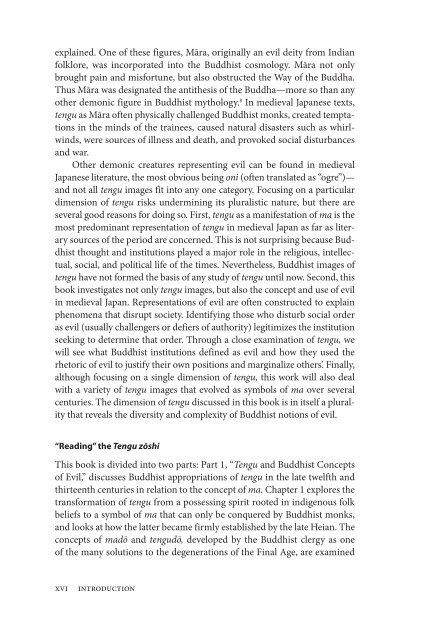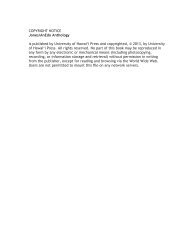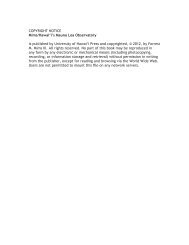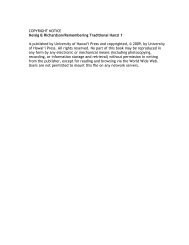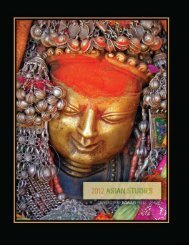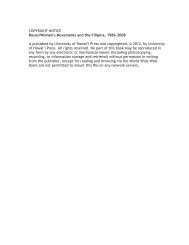COPYRIGHT NOTICE Wakabayashi/The Seven Tengu Scrolls is ...
COPYRIGHT NOTICE Wakabayashi/The Seven Tengu Scrolls is ...
COPYRIGHT NOTICE Wakabayashi/The Seven Tengu Scrolls is ...
You also want an ePaper? Increase the reach of your titles
YUMPU automatically turns print PDFs into web optimized ePapers that Google loves.
explained. One of these figures, Māra, originally an evil deity from Indian<br />
folklore, was incorporated into the Buddh<strong>is</strong>t cosmology. Māra not only<br />
brought pain and m<strong>is</strong>fortune, but also obstructed the Way of the Buddha.<br />
Thus Māra was designated the antithes<strong>is</strong> of the Buddha—more so than any<br />
other demonic figure in Buddh<strong>is</strong>t mythology. 8 In medieval Japanese texts,<br />
tengu as Māra often physically challenged Buddh<strong>is</strong>t monks, created temptations<br />
in the minds of the trainees, caused natural d<strong>is</strong>asters such as whirlwinds,<br />
were sources of illness and death, and provoked social d<strong>is</strong>turbances<br />
and war.<br />
Other demonic creatures representing evil can be found in medieval<br />
Japanese literature, the most obvious being oni (often translated as “ogre”)—<br />
and not all tengu images fit into any one category. Focusing on a particular<br />
dimension of tengu r<strong>is</strong>ks undermining its plural<strong>is</strong>tic nature, but there are<br />
several good reasons for doing so. First, tengu as a manifestation of ma <strong>is</strong> the<br />
most predominant representation of tengu in medieval Japan as far as literary<br />
sources of the period are concerned. Th<strong>is</strong> <strong>is</strong> not surpr<strong>is</strong>ing because Buddh<strong>is</strong>t<br />
thought and institutions played a major role in the religious, intellectual,<br />
social, and political life of the times. Nevertheless, Buddh<strong>is</strong>t images of<br />
tengu have not formed the bas<strong>is</strong> of any study of tengu until now. Second, th<strong>is</strong><br />
book investigates not only tengu images, but also the concept and use of evil<br />
in medieval Japan. Representations of evil are often constructed to explain<br />
phenomena that d<strong>is</strong>rupt society. Identifying those who d<strong>is</strong>turb social order<br />
as evil (usually challengers or defiers of authority) legitimizes the institution<br />
seeking to determine that order. Through a close examination of tengu, we<br />
will see what Buddh<strong>is</strong>t institutions defined as evil and how they used the<br />
rhetoric of evil to justify their own positions and marginalize others’. Finally,<br />
although focusing on a single dimension of tengu, th<strong>is</strong> work will also deal<br />
with a variety of tengu images that evolved as symbols of ma over several<br />
centuries. <strong>The</strong> dimension of tengu d<strong>is</strong>cussed in th<strong>is</strong> book <strong>is</strong> in itself a plurality<br />
that reveals the diversity and complexity of Buddh<strong>is</strong>t notions of evil.<br />
“Reading” the <strong>Tengu</strong> zōshi<br />
Th<strong>is</strong> book <strong>is</strong> divided into two parts: Part 1, “<strong>Tengu</strong> and Buddh<strong>is</strong>t Concepts<br />
of Evil,” d<strong>is</strong>cusses Buddh<strong>is</strong>t appropriations of tengu in the late twelfth and<br />
thirteenth centuries in relation to the concept of ma. Chapter 1 explores the<br />
transformation of tengu from a possessing spirit rooted in indigenous folk<br />
beliefs to a symbol of ma that can only be conquered by Buddh<strong>is</strong>t monks,<br />
and looks at how the latter became firmly establ<strong>is</strong>hed by the late Heian. <strong>The</strong><br />
concepts of madō and tengudō, developed by the Buddh<strong>is</strong>t clergy as one<br />
of the many solutions to the degenerations of the Final Age, are examined<br />
xvi introduction


